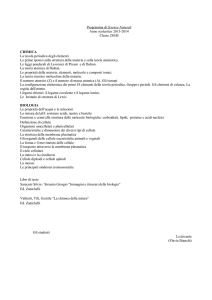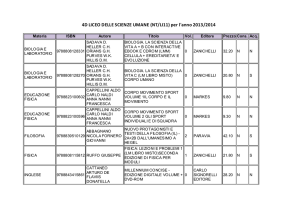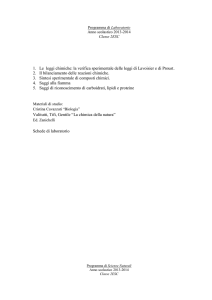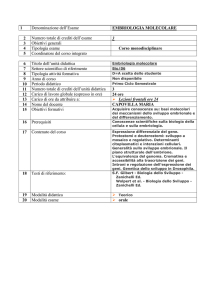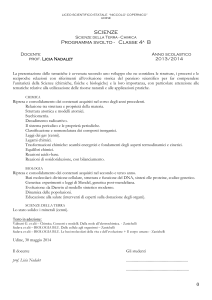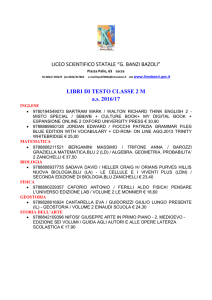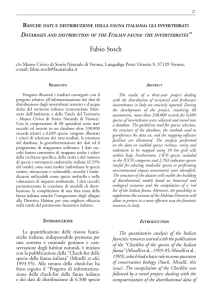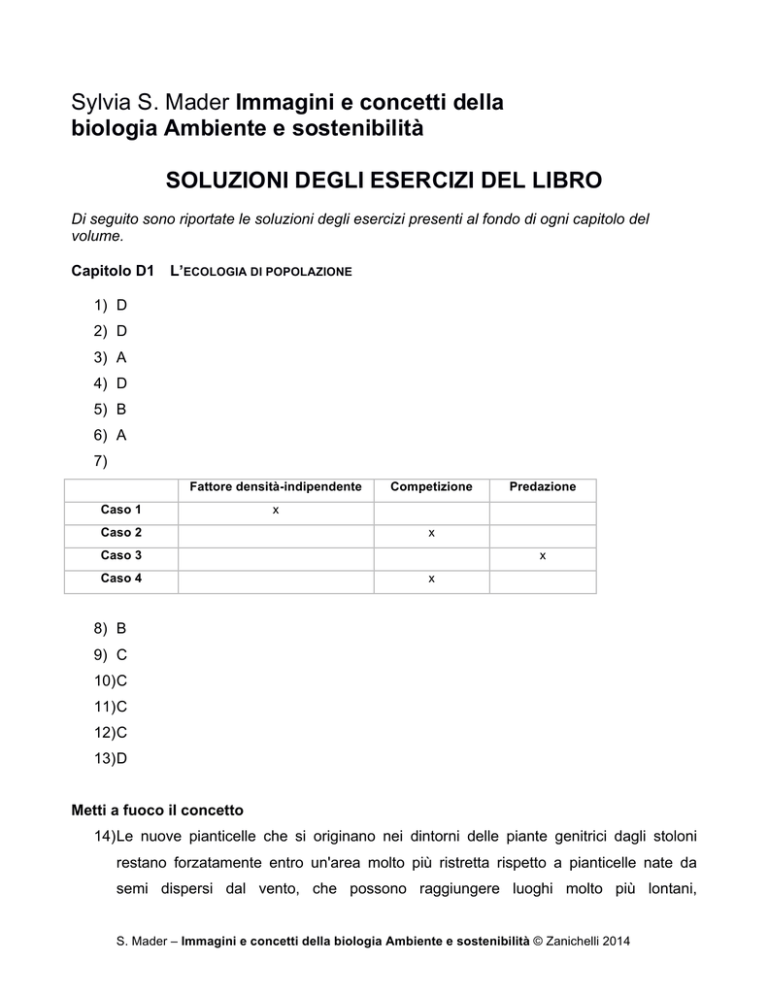
Sylvia S. Mader Immagini e concetti della
biologia Ambiente e sostenibilità
SOLUZIONI DEGLI ESERCIZI DEL LIBRO
Di seguito sono riportate le soluzioni degli esercizi presenti al fondo di ogni capitolo del
volume.
Capitolo D1
L’ECOLOGIA DI POPOLAZIONE
1) D
2) D
3) A
4) D
5) B
6) A
7)
Fattore densità-indipendente
Caso 1
Caso 2
Competizione
x
x
Caso 3
Caso 4
Predazione
x
x
8) B
9) C
10) C
11) C
12) C
13) D
Metti a fuoco il concetto
14) Le nuove pianticelle che si originano nei dintorni delle piante genitrici dagli stoloni
restano forzatamente entro un'area molto più ristretta rispetto a pianticelle nate da
semi dispersi dal vento, che possono raggiungere luoghi molto più lontani,
S. Mader – Immagini e concetti della biologia Ambiente e sostenibilità © Zanichelli 2014
aumentando l’estensione dell’areale.
15) Quando l’ambiente è instabile, a causa sia di fattori densità-indipendenti sia di fattori
densità-indipendenti, almeno pochi dei molti discendenti di piccola taglia e non accuditi
potrebbero avere qualche possibilità di sopravvivere e di disperdersi fino ad ambienti
favorevoli, rispetto a specie meno adattabili.
16) Le barriere coralline sono ecosistemi molto produttivi e questo spiega la presenza di
molte specie. Il fatto di riprodursi in periodi diversi dell’anno diminuisce la competizione
per le risorse, particolarmente intensa nel periodo in cui i coralli si riproducono.
Acquisisci i termini
17) a) risorse
b) fattori limitanti
c) areale
d) coorte
e) piramide
Understanding the terms
18) a) demographic transitino
b) population
c) exponential growth
d) biotic potential
Thinking scientifically
19) The right whale has only one offspring per reproduction and chances of death before
maturity is good. The right whale begins reproducing well after maturity, and
reproduce infrequently. To test your hypothesis, you would have to observe a captive
population or tag individuals in the wild and observe them from a distance.
20) Determine the original normal flow of the river and maintain the flow as close to
normal as possible.
21) A species with various and interconnected populations is more viable than an isolated
population without genetic change and without possibility of dispersal in a single (even
if large) isolated protected area.
22) No, it would not be a good idea, because the uncontrolled deer population (without its
predators) will expand and consume all the resources, dropping rapidly in number for
starvation and destroying the vegetation of the forest.
23) In a more biodiverse environment, there are better chances that pests are controlled
by their natural predators; moreover, pests do not easily find small extensions of the
same crop and there is less possibility of invasions.
S. Mader – Immagini e concetti della biologia Ambiente e sostenibilità © Zanichelli 2014
24) At the starting point, the introduced predator finds much food, but soon plant and
predator populations can reach an equilibrium: the best scenario is that the insect
does not eat other valuable plants, but it is not guaranteed. The worst scenario (more
likely) is that the introduced predator targets other plant species, causing a lack of
balance for local equilibrium.
Capitolo D2
L’ECOLOGIA DEL COMPORTAMENTO
1) C
2) B
3) D
4) C
5) C
6)
Caso 1
Comunicazione
Comunicazione
Comunicazione
Comunicazione
chimica
sonora
visuale
tattile
x
Caso 2
Caso 3
Caso 4
x
x
x
x
7) A
8) D
9) D
10) C
Metti a fuoco il concetto
11) Le femmine, che producono pochi gameti e quindi sono in grado di produrre una prole
limitata nel corso della vita, hanno un vantaggio a scegliere il maschio più adatto per
garantire la qualità genetica dei propri figli. I maschi, d’altra parte, producono molti
gameti e tendono a produrre il numero massimo di discendenti cercando di accoppiarsi
con il massimo numero di femmine. Entrambi questi comportamenti sono mantenuti
S. Mader – Immagini e concetti della biologia Ambiente e sostenibilità © Zanichelli 2014
dalla selezione naturale perché, da una parte, le femmine che compiono la scelta
«giusta» del compagno producono prole con gli stessi geni «della selezione del
partner» e, dall’altra parte, i maschi producono una prole numerosa che eredita i geni
«della conquista».
12) Aiutando i genitori ad allevare i propri fratelli, gli helper aumentano la propria fitness
complessiva mentre non possono ancora riprodursi (selezione di parentela); inoltre,
hanno maggiore probabilità di ereditare il territorio parentale e di essere a loro volta
beneficiari di altruismo reciproco da parte di figli futuri.
13) Un maschio dominante di babbuino deve mantenersi fisicamente efficiente, affrontare i
rivali e dissuadere i predatori (costi); in cambio, ha accesso preferenziale alle femmine
e quindi ha un grosso vantaggio riproduttivo (cioè di fitness complessiva).
14) Favorire i propri parenti, anche se non ci si riproduce individualmente, favorisce
comunque la persistenza di quella percentuale di geni che ogni individuo condivide con
gli individui affini: fratelli e sorelle, nipoti, cugini ecc.
Acquisisci i termini
15) a) apprendimento b) periodo sensibile c) comunicazione
d) selezione di parentela
e) helper
Understanding the terms
16) a) territoriality
b) reciprocal altruism
c) pheromone
Thinking scientifically
17) Mate the two types of rats and test how the offspring react to Limburger cheese. If they
show an intermediate response, such as being willing to approach the cheese but still
not eating it, then the behavior may be genetically controlled.
18) Observe sentry behavior more closely. Recent observations have shown that sentries
are the first ones to reach safety when a predator is spotted, and meerkats only serve
as sentries after they have eaten.
19) The correct answer is (c).
S. Mader – Immagini e concetti della biologia Ambiente e sostenibilità © Zanichelli 2014
Capitolo D3
LE COMUNITÀ E GLI ECOSISTEMI
1) C
2) D
3) B
4) A
5) A
6)
Competizione
Predazione
Parassitismo
Commensalismo
Caso 1
Caso 2
Mutualismo
x
x
Caso 3
Caso 4
Caso 5
x
x
x
7) B
8) D
9) C
10) C
11) D
12) D
Metti a fuoco il concetto
13) L’area che sto considerando può ancora accogliere le richieste tipiche della nicchia
ecologica della specie predatrice che vorrei reintrodurre. In altre parole, le sue
potenziali prede sono presenti con una popolazione sufficiente.
14) No: le specie fotosintetiche sono autotrofe e perciò occupano comunque il livello di
produttori, cioè il primo livello della catena trofica, mentre le specie non fotosintetiche
si trovano sempre a livelli trofici superiori, ossia di consumatori.
15) La perdita di biomassa (e di energia) lungo una catena alimentare è dovuta da una
parte all’uso dei materiali per l’accrescimento e dall’altra alla dispersione dell’energia
sotto forma di calore, tipico delle reazioni metaboliche degli organismi. Disegnando
una piramide ecologica, l’erba rappresenta il livello trofico dei produttori, i conigli sono
S. Mader – Immagini e concetti della biologia Ambiente e sostenibilità © Zanichelli 2014
consumatori primari (sono erbivori), i serpenti sono consumatori secondari (predano i
conigli), mentre le poiane sono consumatori terziari, nutrendosi a loro volta di carnivori.
16) Perché gli scambi nel ciclo del carbonio avvengono tutti a livello gassoso (CO2) sia
per quanto riguarda la fotosintesi sia per la combustione di legname e combustibili di
vario genere, e anche quelli tra le acque e l’atmosfera.
Acquisisci i termini
17) a) mutualismo
b) rete del detrito
d) serbatoio di scambio
c) piramide ecologica
e) eutrofizzazione
Understanding the terms
18) a) community
b) habitat
c) ecological niche
Thinking scientifically
19) Carefully observe the birds to see if they differ in ways suggested by figure 3.10, and
then collect all the data in a field schedule.
20) Fill a large container with water from the pond, then slowly add phosphate over several
days or weeks, and when you observe growth calculate the amount of phosphate you
need for the entire pond.
21) Due to biodiversity, some species may not be susceptible to the assault; and the
susceptible plants may be protected by the unsusceptible ones. For example, insects
may not find all the susceptible individuals.
22) Yellow space: Reservoirs
Blue space: Exchange pool
Green space: Biotic community
Capitolo D4
LA CONSERVAZIONE DELLA BIODIVERSITÀ
1) D
2) A
3) B
4) B
5) D
S. Mader – Immagini e concetti della biologia Ambiente e sostenibilità © Zanichelli 2014
6) D
7)
Core area
Zona tampone
Caso 1
Corridoio ecologico
Stepping zone
x
Caso 2
x
Caso 3
x
Caso 4
x
8) D
9) A
10) D
11) B
12) D
13) D
Acquisisci i termini
17) a) diversità di paesaggio
d) eradicazione
b) valore intrinseco
c) sovrasfruttamento
e) corridoio ecologico
Understanding the terms
18) a) biodiversity hotspot
d) sink population
b) metapopulation
c) source population
e) overexploitation
Thinking scientifically
19) Overharvesting reduces genetic diversity due to bottleneck effect, like happened in the
cheetah’s populations, where the reduction of the number of specimens caused a
drastic loss of genetic diversity. To test the genetic diversity of a population you have
to determine how many loci are now homozygous in the specimens of the population
itself.
20) Besides having produced a population with limited genetic diversity, none of the
problems that brought the species to near extinction have been solved.
21) Habitat loss is the main cause of wildlife extinction: for preserving biodiversity is
S. Mader – Immagini e concetti della biologia Ambiente e sostenibilità © Zanichelli 2014
necessary a net of protected areas. Without large protected areas or interconnected
ones, soils and freshwaters loose nutrients. An effective habitat restoration plan has to
maintain the size of existing natural fragments, and restore corridors to connect core
areas because landscape protection for one or few species is often beneficial for
others.
22) Islands have unique native species that are closely adapted to one another and cannot
compete against alien species. Similarly, a fragment of forest in a cultivated landscape
hosts animals species that could not survive outside that habitat, because solar
radiation is too strong, it is difficult to find food and water as well as avoiding predators.
23) The loss of habitats due to anthropic activities is the main threat migrating birds face
and it could have a dramatic impact on the birds’ chances of survival. These habitats
are distributed in many countries, so international cooperation between governments
and other stakeholders is necessary along the entire flyway of species, in order to
share knowledge and to coordinate conservation efforts.
24) Alien species are nonnative animals or plants introduced in habitats with no natural
predators or competitors. Eradication, or the physical removal of alien species from the
interested area, is the most effective practice to reduce its negative impact on the
natural balance of the area.
S. Mader – Immagini e concetti della biologia Ambiente e sostenibilità © Zanichelli 2014

